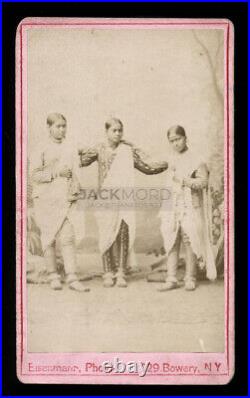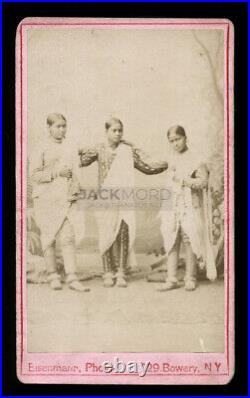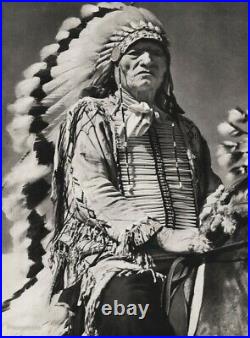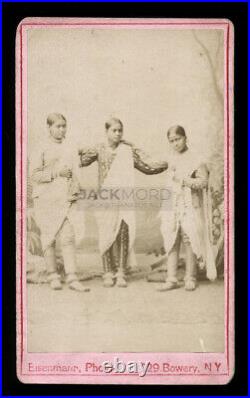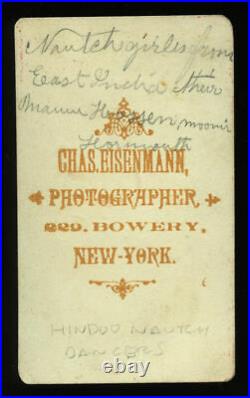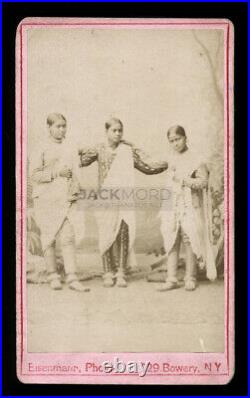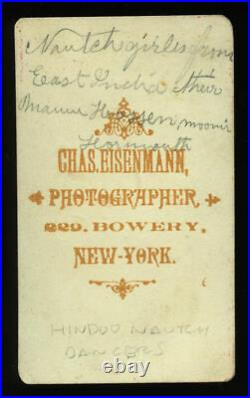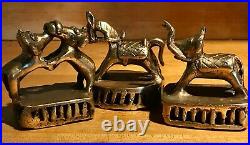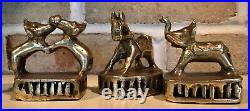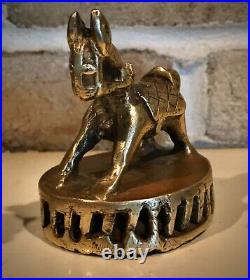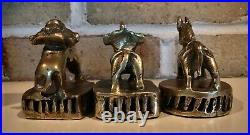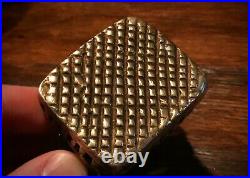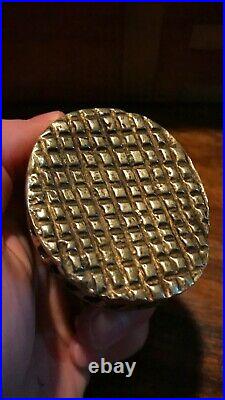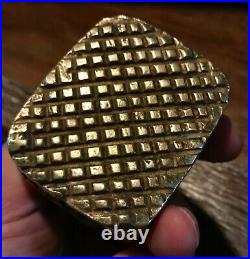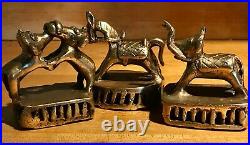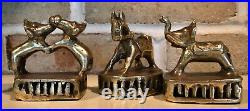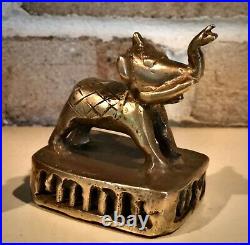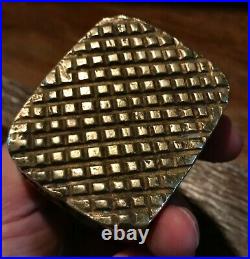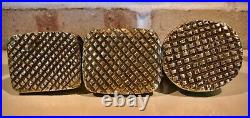
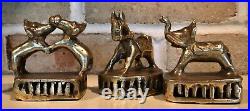

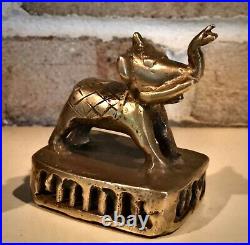

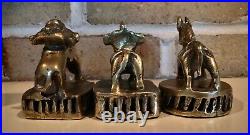

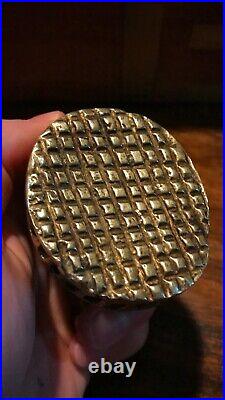
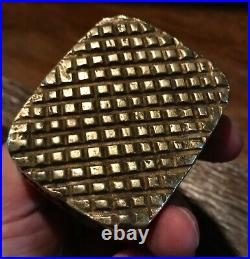


This is a STUNNING trio composed of heavy, solid brass 1800s high detail Indian Vajri. Simply put, this set showcases some of the most exquisite brass detailing I’ve seen in my now many, many years as a cultural ethnicities and antiquities collector. Normally, genuine antique Indian Vajri are very basic and straightforward in structure. In other words, they are functionality based – with little attention given to aesthetic and artistic composition. This set, however, puts on a display of truly magnificent and masterful manipulation of brass to create what could be described as nothing short of showcase sculpture. Made using the “lost wax” technique, the attention to detail, and meticulous precision throughout the process – means that this set of Vajri are about as far from “solely functional” as possible. While the vast majority of Vajri were simple, straightforward, crudely formed – a few of these pieces were exquisitely crafted. These Vajri were more “work of art” than “functional” items, and marketed to the wealthier members of Indian society. This Vajri set was undeniably one of those few Vajri that valued aesthetic composition over functional use. In short, this set is representative of the finest, hardest to find 1800s Antique Indian Vajri. You simply will not find pieces belonging to the Vajri group of this calibre and craftsmanship. These Vajri are most at home these days displayed on a shelf in the communal room. Throughout our time owning and displaying this set, we have had more interest, more admiration from visiting guests than we’ve seen shown for any of our other antique decorative displays. A conversation set, no doubt, and a stunningly beautiful one at that. For those unfamiliar with the original use of antique 1800s Indian Vajri – these pieces were typically used by women when bathing, often times to scrub the feet. Most of the Indian population of the time were without shoes, making the course bottoms of these brass scrubbers a necessity. In the finer Vajri, a figure of sorts (elevated on a pedestal) served as a makeshift handle. Small pebbles or rocks (or tiny brass balls with the more expensive Vajri) are housed within the caged bases of the Vajri. In india during the time, bathing was often communal and occurred in a public space (stream, pond, or a river). When the Vajri were being used, the small pebbles/rocks/brass balls rattled, warning off others in the vicinity that women were in the process of bathing nearby. These are very HEAVY, (the set weighs 2 POUNDS 3.4 OUNCES). Very solid brass in composition. The brass has a wonderful deep warm gold luster, free from dulling, blackening tarnish. Perhaps one of my favorite aesthetic elements of this set – you can tell they are indeed very old, yet – they still possess a truly eye catching gleam. I have these pieces displays on a shelf under artificial/warm lighting. The look is impossible to miss. Vajri One: Elephants at Play. This Vajri depicts two young elephants, in a pose that one would expect to find in a circus performance. The two elephants are reared up on their hind legs, front feet touching to hold their balance. Their trunks are intertwined. Their short little tails hang to the side off of their chubby rumps. Their facial features are quite simple – almost “child-like” in their depiction. This is a cute piece – one that depicts the play of elephant calves. Their simplistic, yet warm features fit perfectly this theme of blissful youth. The elephant calves are high polish, on a somewhat matte brass base. The base is squared in nature, and features vertical spaced brass bars. These bars keep the little brass balls at the interior contained. This Vajri gives off quite the loud, very audible rattle. The bottom of the base is covered in beautifully raised brass “checkers, ” with oxidization filling in the creases between each segmented element of high polish brass. The bottom truly gleams – and has a wonderful depth of texture. Weight: 11.9 Ounces – 337 Grams. Dimensions: Base 5.5 cm Length x 4.5 cm Width. Overall Height: 7 cm. Overall Length (front to back) 7 cm. Vajri Two: The Ornate Horse. This Vajri depicts that of a horse, though – not just any horse. The beat is clad in a stunning assortment of regal adornments. The horse wears a brass mask of sorts, of which the reins are attached. The animal’s ears are raised at attention – looking as though it expects to be mounted by rider imminently. The horse’s saddle is meticulously detailed, with finite hand cut etchings throughout. Anatomically, this horse has a artistically rendered aesthetic. Though clear in its depiction, proportionally the artist has taken some freedom in his/her design. I love the strength this little horse emanates – so stocky and sturdy in its solid brass complexion. The horse sits on a matte brass ovular base. The base is space with slightly diagonal brass bars in order to keep the brass rattle balls contained within. Very loud and audible rattle when shaken. The bottom of the base is checkered HIGH polish brass – very luminous. The checkered pattern is raised, and has a wonderful feel to the touch. Weight: 11.7 Ounces – 331 Grams. Dimensions: Base 6.5 cm Length x 5.5 cm Width. Overall Length (front to back) 6 cm. Vajri Three: The Bull Elephant. This piece pairs perfectly with the aforementioned Vajri depicting the young elephant calves. This Vajri, however, depicts that of the developed male elephant – the pack leader – the bull. This elephant is THICK and substantial in size – and strikes a majestic pose. The elephants trunk is raised highly into the air, nestled in between two bold and foreboding tusks. Thick and wide, a large mounting saddle sits on this bull’s back. An intimidating thought that a beast of such scale is sometimes actually mounted (and ridden) by a slight framed and comparatively fragile human being. The saddle bears diamond pattern etchings, and rests on the elephants back like a sort of thick blanket. The beast bears the same style of facial feature as the Vajri depicting the younger elephants, though here the eyes are slightly more aggressive looking in nature. This is a beast that can be made to do what comes unnaturally, though never truly domesticated. I believe the artist captures the essence of this stunning creature and its relationship with man quite beautifully. The adult bull elephant sits on a squared base of matte brass. Like the other Vajri in this set, the base boasts vertical brass bears which keep the brass rattle balls contained within. Again loud and audible when shaken. The bottom of the base is again checkered brass in nature – there is symmetry in the checkered brass pattern, though slight variation that showcases the work of human hands. Perfect in their slight imperfection, these Vajri are. Dimensions: Base 6 cm Length x 5 cm Width. Overall Height: 6.5 cm. This is a stunning example of antique Indian art. A testament to their builder that all these years later (these were made in the early 19th century) not only are these Vajri still intact, but they still radiate in their quality. I assure you that these Vajri are all the more stunning in person. They are a must have collectible for the fan of authentic Indian antiquity. If I had someone to pass these pieces on down to, I assure you they would not have found their way onto my active listings page. Irreplaceable – one of a kind – and (I hope) destined to find a new owner who will appreciate them as much as I have. I will get back to you promptly. This item is in the category “Antiques\Asian Antiques\India”. The seller is “uniqueluxurygoods” and is located in this country: US. This item can be shipped worldwide.
- Region of Origin: India
- Depiction: Circus Animals
- Item Type: Vajri
- Age: 1800-1849
- Primary Material: Brass
- Maker: Unsigned
- Original/Reproduction: Antique Original
- Type: Sculpture
- Color: Gold

